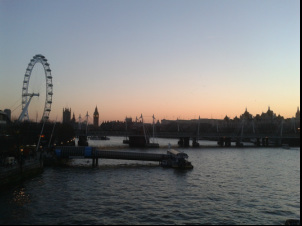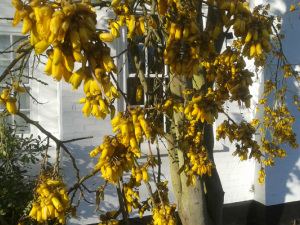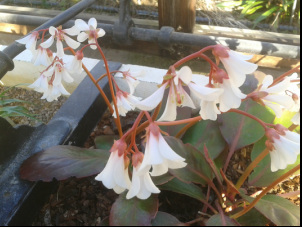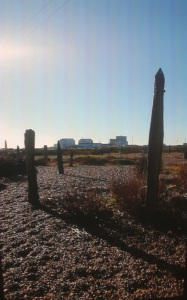



The film 'The Garden' with the item from Gardener's World is showing again at the BFI on Tuesday 18 March at 20.40
All quotations from derek jarman's garden (Thames & Hudson 1995)
|
|
 To London (suddenly I feel like Pepys) last weekend to see Derek Jarman’s 1990 film The Garden. In my New Year anxiety to be part of the commemorative festival ‘Jarman 2014’, I booked tickets for the showing I could get to most easily and at the time was disappointed by the choice: I was really hankering after his version of Edward II, or The Tempest, perhaps. This is particularly strange even from my forgetful head: after all, it was his extraordinary interpretation of the term ‘garden’ at his Dungeness home which provided the emotional charge to send me on my own garden path: last May’s post tells this story. Anyway, there was plenty of time on this heavenly spring day to take in ‘Pandemonium’, the wonderful exhibition of Jarman’s life and work at Somerset House and then a walk, with him in spirit, across Waterloo Bridge, a favourite from my student days, the skyline to the west reduced to a planetarium silhouette in the afternoon sun. Even when we’re seated at the BFI I’m still not quite with it until Keith Collins, Derek’s long-term collaborator and partner, is there (for this occasion only) to introduce the film and its accompanying clip from Gardener’s World featuring the Dungeness garden. There. In person. Looking exactly like himself, 'HB', as if he’s stepped straight out of the familiar photographs, and different too of course, twenty years on – a fabulous mane of dark hair half way down his back for a start. Pow!  Meanwhile spring is in the air – I can hear it in the voices on the street outside my window, smell it in the mown grass – and March is packing its own technicolour punch, the willows on the Cam turned lemon-green overnight, street-corner magnolias blushing as they bud and the blackthorn at the back of my house a froth of creamy white. At the Botanics, catkins a-plenty, cherry blossom, and golden carpets of primrose and wild daffodil punctuated with the electric blue stars of Scilla siberica (not Siberian, in fact, nor any relation to Scylla, that half of the monstrous pair who lured unsuspecting sailors to their doom). I like the sound of squill, though – a Dickensian ring to it, somehow. The prize for the gaudiest gold of the moment has to go to the Sophora microphylla ‘kowhai’, currently in full bloom on the south wall of Cory Lodge and loud with honey bees.  The kowhai is native to Chile and New Zealand so, like many of the wonders in the Garden, has at some point in its history made the journey across the world to be here. I’m fascinated still by the plant hunters who made these journeys possible and curious to know how the passion is realised now. I’m two steps nearer to finding out: a roundabout route takes me in search of Bergenia emeiensis, all the way from Mount Emei in China and currently flowering prettily in the Alpine House. It was introduced into the UK by plantsman and ex-Cambridge student Roy Lancaster. I’m wondering where he is now and how easy it might be to get hold of him when I’m surprised to hear his voice on one of the recordings on Voicing the Garden. A fellow Lancastrian, he was lured to Cambridge not by the Botanic Garden’s reputation but by a girl. In another quirk of synchronicity, the Garden Museum’s Spring Journal is a publication of Michael Wickenden’s lecture ‘The Nurseryman as Plant Hunter’. Michael Wickenden, I learn, has a nursery Cally Gardens on the Scottish border, and many of his plants come from seeds from botanic gardens worldwide and from plant hunting expeditions, presumably some in which he took part. He has undertaken expeditions all over the world and argues passionately for the right to propagate plants without legal limits.  A different approach to gardening, I suppose, is to look at what grows well in a particular environment and work from there. Jarman’s Dungeness garden is a good example, the broom and gorse rubbing shoulders with viper’s bugloss and the perennial pea, the sea pea. Jarman filled his garden not just with living things but fragments of the land itself, shingle and flints and stones, and with driftwood and debris abandoned to wind and weather or washed up by the tide. ‘The garden is full of metal: rusty metal corkscrew clumps, anchors from the beach, twisted metal, an old table-top with a hole for the umbrella, an old window, chains which form circles round the plants. All this disappears in the burgeoning spring…’ when ‘...the inky purple Crambe maritima uncurl like medieval capitals’. Sea kale, the most prolific plant of the Ness, is edible, related to cabbage, and the blanched shoots can be served like asparagus but they absorb more radioactivity from the adjacent nuclear power station, apparently, than any other plant. Jarman loved his garden, termed it ‘paradise’, both a ‘therapy’ and a ‘pharmacopoeia’ . 'Pandemonium', presented by the Cultural Institute at King's, was in the Inigo Rooms, Somerset House East Wing: sadly Sunday 9 March was the last day.
The film 'The Garden' with the item from Gardener's World is showing again at the BFI on Tuesday 18 March at 20.40 All quotations from derek jarman's garden (Thames & Hudson 1995)
1 Comment
Tim Holt-Wilson
18/3/2014 04:44:54 am
CRAMBE !
Reply
Leave a Reply. |
At HomeAs Writer in Residence, thoughts from the garden Archives
October 2020
Categories |